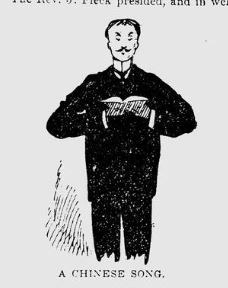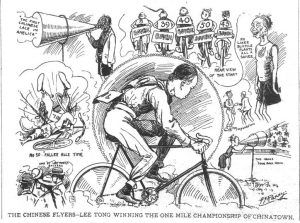Researched and written by Aamna Rashid
Edith Eaton, in her article, “Chinese Entertainment, at Which the Chinamen Did Their Share of the Entertaining” first mentioned Lee Tong while discussing a night of entertainment at St Paul’s Church lecture room where “all the Chinese talent of Montreal was there” (Sin Far 82). This account of a gathering of thirteen Chinese Sunday schools was published in Montreal Daily Star, on 31 December 1895 and depicts the different recitations, in both English and Chinese performed at the event. Lee Tong is mentioned by name for reciting the commandments.
Another article in The Montreal Daily Witness published 29th December 1896, “Chinaman make Merry” describes an orchestra held for the Chinese New Year for “John Chinaman’s” (a racial slur for Chinese people) at Knox Church. Coupled with caricatural illustrations of the performers, the article mentions Lee Tong at the same event reciting The Sabbath in Cantonese, depicting a similar interpolation between Christianity and the Chinese community. Fig.1 could possibly be a representation of Lee Tong but it is hard to confirm because of its lack of detailed captioning.

Fig 1: “A Chinese Song”, The Montreal Daily Witness, 29th December 1896, pg. 11.
Though these are evidence of Lee Tong’s involvement within the Chinese community as well as Christian Sunday school, two other articles reference a Lee Tong who completed in bicycle races, demonstrating an important aspect of entertainment and hobbies within the Chinese community. The first, titled “Chinamen on wheels cause much entertainment on the tracks” recounts a race held at the Montreal Amateur Athletic Association (MAAA) grounds for the Montreal Bicycle Club (MBC) in 1898. The article was published 29th August 1898 and devotes a section commenting on the “amusing” nature of seeing Chinese cyclists. Of course, the racial undertones represent the racialization of the Chinese community but inadvertently, it documented an important aspect of Chinese-Canadian history and their participation in MBC’s events. It describes the race between “Tong Kim, Yep Sing, Loe Tong, Ham Koon and Foog Son,”, misspelling Lee Tong’s name here. Later, it describes how “Lee Tong was the only man who did not tumble and he won easily”, accompanying this claim with an illustration of him winning the race, accompanied by caricatural depictions of the other Chinese racers (Fig 2).

Fig 2: “Chinamen on wheels cause much entertainment on the tracks” The Daily Witness, 29 août 1898.
The article highlighted that “ The race created so much excitement and amusement that the committee ‘decided to have a consolation race, which was also à great success”, pointing to the growing involvement of the Chinese-Canadian community. On 4th September 1899, The Herald published an article on the 44th annual field day of the Caledonian Society held similarly at the MAAA grounds and clubhouse. It shows Lee Tong competing again and finishing second in the race, with Song Sing coming first and Tom Kim (another previously mentioned cyclist) as third. It further demonstrates a separation in races by race, at least in these examples but most significantly, visualises recreation activities and hobbies that the Chinese-Canadian community held, a fact that was usually overshadowed by their racialisation and criminalization in newspapers.
In other entries, an association of Lee Tong with liquor and opium smuggling within news reports begin. One article “Corrupting a Witness” (1st October 1898) specifically refers to Lee Tong, the cyclist, and connects him with the arrest of Lee Chu of Lagauchetiere Street. It states “through the aid of Lee Tong, the Chinese bicyclist of Amherst street, the Revenue Department were able to raid Lee Chou’s premises, where they located one thousand bottles of liquor.” It further alleges that Lee Chou offered Tong a bribe of 100$ to keep silent but he refused. An account of the same story is present in “UNE AUTRE TOUANURE” La patrie, 27 octobre 1898 and “Lee Chu Bribery Case”, the Gazette, 27 October 1898 that followed the trial and instead alleges that Lee Tong had offered 100$ to Lee Chu(Chou) to act as his witness and that Chu had refused, deciding to plead guilty. Tong Hill and Lee Fook, other “Chinamen”, acted as witnesses in the case stating “On September 29th, they saw Song Sing and Lee Tong at the store of the accused….[where] Lee Tong made some remark about coming to help him out for 100$.”
While I was unable to find a definitive conclusion of the trial, another newspaper article detailed a Lee Tong’s involvement with opium dealing, citing 2 different addresses for him, 672 Lagauchetiere Street and 572 Lagauchetiere Street (possible typo) as they were published in 1902 – 14th May and 19th May respectively. Lagauchetiere Street at this time was known as the site for Chinese boarding houses for new immigrants and held a semblance of community. The first article merely announces his court date (set as 19th May) and the charge of opium dealing while the second details him being charged for the crime. It describes him as being well known to the police as an opium dealer and “as an old man of singular appearance….weighing out the opium paste demanded by his patrons”, charged a fine of 20$ and 90 days imprisonment. The article points to the hypocrisy of the West when reporting on the Chinese community claiming “the West has surely enough vices of its own without those of the Orient” as well as the common tropes within newspapers of associating opium sales with the Chinese community.
While I have been unable to discern Lee Tong’s exact date of immigration, date of birth, or death due to the commonality of the name, what this points towards is a diverse history of the Chinese community and individuality despite a similar name or alternatively the possibilities of changing circumstances driving different “business” endeavors even if these are all tales of the same Lee Tong. In either consideration, what remains especially significant is that it provides a story and background to immigrants, otherwise deprived of history, personhood, and hobbies, and prevents their reduction to statistics in historical imagining.
“A Chinese Song”, The Montreal Daily Witness, 29th December 1896, pg.11 https://numerique.banq.qc.ca/patrimoine/details/52327/4666956?docsearchtext=lee%20tong
“Chinamen on wheels cause much entertainment on the tracks” The Daily Witness, 29 août 1898, pg.10 https://numerique.banq.qc.ca/patrimoine/details/52327/4702390?docsearchtext=lee%20tong
“Corrupting a Witness,” The Daily Witness, 1 october 1898, pg. 6
https://numerique.banq.qc.ca/patrimoine/details/52327/4702419?docsearchtext=lee%20tong
“The Scots A-Field”, The Herald, 4 septembre 1899, pg. 5
https://numerique.banq.qc.ca/patrimoine/details/52327/4463994?docsearchtext=lee%20tong
“City Items”, The Daily Witness, mercredi 14 mai 1902, pg.6 https://numerique.banq.qc.ca/patrimoine/details/52327/4703575?docsearchtext=city%20items
“For selling opium” The Daily Witness, 19 mai 1902, pg.1 https://numerique.banq.qc.ca/patrimoine/details/52327/4703579?docsearchtext=lee%20tong
